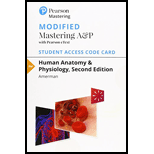
Modified Masteringa&p With Pearson Etext -- Standalone Access Card -- For Human Anatomy And Physiology
2nd Edition
ISBN: 9780134788074
Author: AMERMAN, Erin C.
Publisher: Pearson Education Canada
expand_more
expand_more
format_list_bulleted
Question
Chapter 11.1, Problem 2QC
Summary Introduction
To review:
The organs of the PNS (peripheral nervous system).
Introduction:
The coordination of the actions of the body is supervised by the nervous system. The transmission of signals received from different parts of the body helps in this coordination. A change in the environment is called a stimulus. This change induces a change in the body. The nervous system has two parts, namely, the central nervous system (CNS) and the PNS.
Expert Solution & Answer
Want to see the full answer?
Check out a sample textbook solution
Students have asked these similar questions
how can nervous system regulate the internal environment of PNS?
Describe the anatomy and function of the PNS.
Which subdivisions of the PNS control voluntary actions?Involuntary actions?
Chapter 11 Solutions
Modified Masteringa&p With Pearson Etext -- Standalone Access Card -- For Human Anatomy And Physiology
Ch. 11.1 - What are the organs of the CNS?Ch. 11.1 - Prob. 2QCCh. 11.1 - Describe the sensory, integrative, and motor...Ch. 11.1 - 4. What are the differences between the somatic...Ch. 11.1 - How does the somatic motor division of the PNS...Ch. 11.2 - What are the functions of the cell body,...Ch. 11.2 - What are the structural differences between...Ch. 11.2 - What are the functional differences between...Ch. 11.2 - What are the functions of astrocytes?Ch. 11.2 - Prob. 5QC
Ch. 11.2 - Prob. 6QCCh. 11.2 - 7. What is the function of the myelin sheath?
Ch. 11.2 - How does the myelin sheath differ in the CNS and...Ch. 11.2 - Are neurons more likely to regenerate in the CNS...Ch. 11.2 - Prob. 10QCCh. 11.3 - 1. What is the resting membrane potential?
Ch. 11.3 - In and around the axon, where is the higher...Ch. 11.3 - Prob. 3QCCh. 11.3 - 4. Define local potential. Why is it also called...Ch. 11.3 - Why are local potentials useful only for...Ch. 11.3 - What takes place during the depolarization phase...Ch. 11.3 - 7. What must be reached in order for...Ch. 11.3 - 8. What takes place during the repolarization and...Ch. 11.3 - 9. What are the absolute and relative refractory...Ch. 11.3 - 10. How do local potentials and action potentials...Ch. 11.3 - Which is useful for long-distance signaling, and...Ch. 11.3 - 12. How is an action potential propagated down an...Ch. 11.3 - Prob. 13QCCh. 11.4 - What are three locations where presynaptic axons...Ch. 11.4 - Define synaptic transmission.Ch. 11.4 - Prob. 3QCCh. 11.4 - How do the two types of postsynaptic potentials...Ch. 11.4 - Prob. 5QCCh. 11.4 - Prob. 6QCCh. 11.5 - Prob. 1QCCh. 11.5 - Prob. 2QCCh. 11.5 - Prob. 3QCCh. 11.5 - Prob. 4QCCh. 11.5 - Prob. 5QCCh. 11.5 - Prob. 6QCCh. 11.6 - 1. Why are neurons organized into neuronal...Ch. 11.6 - Prob. 2QCCh. 11.6 - 3. What mechanisms stabilize neural circuits?
Ch. 11 - Which of the following statements about the...Ch. 11 - 2. Regulation of heart rate, blood pressure, and...Ch. 11 - Match each type of neuroglial cell with its...Ch. 11 - 4. Mark the following statements as true or false....Ch. 11 - 5. An axon is best defined as a process that:
a....Ch. 11 - 6. Fill in the blanks: The myelinated segment of...Ch. 11 - 7. Fill in the blanks: The _______is the period of...Ch. 11 - 8. Which of the following statements best...Ch. 11 - 9. Identify the following as properties of...Ch. 11 - The trigger for exocytosis of synaptic vesicles...Ch. 11 - Match the following neurotransmitters with their...Ch. 11 - 12. Which of the following is not a method by...Ch. 11 - 13. A ________is characterized by multiple input...Ch. 11 - Mark the following statements as true or false. If...Ch. 11 - Sequence the following list of events of a...Ch. 11 - 16. Mark the following statements as true or...Ch. 11 - 1. A drug that blocks channels in neurons does so...Ch. 11 - Prob. 2CYUCh. 11 - Why must a cell body be intact for an axon to...Ch. 11 - 4. Explain how an action potential is propagated...Ch. 11 - Prob. 1AYKACh. 11 - 2. During a surgical procedure, an...Ch. 11 - Albert accidentally ingests the poison...Ch. 11 - 4. Albert, the patient in question 3, takes the...Ch. 11 - Predict the effect that tetrodotoxin would have on...Ch. 11 - Explain what would happen if depolarization of the...
Knowledge Booster
Similar questions
- What type of neurons can be found in the PNS?arrow_forwardWhich subdivision of the PNS is involved in (a) relaying the feeling of a “full stomach” after a meal, (b) contracting the muscles to lift your arm, and (c) increasing your heart rate?arrow_forwardWhich branch of the PNS controls most of the body’s vital functions? What structure is the “boss” of this branch?arrow_forward
arrow_back_ios
SEE MORE QUESTIONS
arrow_forward_ios
Recommended textbooks for you
 Biology (MindTap Course List)BiologyISBN:9781337392938Author:Eldra Solomon, Charles Martin, Diana W. Martin, Linda R. BergPublisher:Cengage Learning
Biology (MindTap Course List)BiologyISBN:9781337392938Author:Eldra Solomon, Charles Martin, Diana W. Martin, Linda R. BergPublisher:Cengage Learning

Biology (MindTap Course List)
Biology
ISBN:9781337392938
Author:Eldra Solomon, Charles Martin, Diana W. Martin, Linda R. Berg
Publisher:Cengage Learning